the Essex GWEN site
Programming note: this post is in color. I will not debase myself to the level of sending HTML email, so if you receive Computers Are Bad by email and want the benefit of the pictures, consider reading this online instead (the link is at the top of the email).
In the aftermath of a nuclear attack, United States military and government policy focuses on one key goal: retaliation. Nuclear policy has long been based on the concept of a credible deterrent, often referred to as mutually assured destruction. It is surprising to some that the technical history of the Cold War is so deeply intertwined with the history of telecommunications technology, but it's obvious in this context: a fundamental part of the nuclear deterrent is a robust, nationwide communications system. For destruction to be mutually assured, we must have confidence that the national command authority will be able to order a nuclear strike under all post-attack conditions.
The post-attack environment is difficult for communications infrastructure. Well, it's difficult for most everything, but communications systems were the topic of extensive research and engineering. During the height of the Cold War, most AT&T long distance facilities were hardened against the blast forces expected from a nuclear attack on a nearby city. Some AT&T facilities, particularly critical to the operation of AUTOVON and other military services that AT&T offered, received more extensive protective measures. Gamma burst detectors would automatically close ventilation dampers in reaction to a nuclear detonation. Redundant, independent utilities and stockpiled supplies would support an underground crew for weeks. The telephone system was more robustly defended than you might think.
The telephone system faces specific challenges in nuclear survival, though, that by the 1980s raised questions about the value of all these efforts. We have previously discussed the rise of the EMP. In that context, I mentioned that the impacts of EMP on military and communications equipment was, in general, not very seriously considered until well after nuclear attack on Japan. Only in the the late '60s did military research into EMP survivability begin on a large scale, much of it under the auspices of the Air Force Weapons Laboratory and its Nuclear Effects Directorate at Kirtland Air Force Base here in Albuquerque [1]. In a YouTube video, I lecture on the history of this work. Among the civilian equipment subjected to the various EMP simulators at Kirtland were telephone equipment furnished by Mountain States Telephone and Telegraph. Telephone systems, including rather substantial lengths of open wire, were also exposed to atmospheric nuclear detonations at the Nevada National Security Site.
Foreshadowing later research into EMP, these tests usually showed surprisingly little effect on the equipment under test. Nonetheless, telephone systems were probably the most vulnerable infrastructure: the many miles of open wire and cables were particularly likely to accumulate large potentials in a nuclear-induced EM field, and the amplifiers and filters used on long distance lines could be damaged by these surges. AT&T shielded equipment against RF and fitted extensive surge protection (important as a precaution against lightning anyway), but it was unclear if even the most hardened telephone systems would be fully functional after a nuclear attack.
Radio is an obvious alternative that comes without the hazards of long wires, but it too struggles with post-attack conditions. Multiple nuclear detonations would cause significant medium-term disturbance of the ionosphere and kick up huge amounts of fallout. These effects create a combination of poor atmospheric propagation and high attenuation that would make HF radio much less effective post-attack. The military and even executive branch agencies had reserve HF communications systems (and continue to today), but once again, it was unclear how effective these would be in the runup to a nuclear reprisal.
During the late '70s and early '80s, a series of trials were performed at Kirtland AFB to investigate the performance of different types of radio systems under high-altitude EMP. Low-frequency systems, like broadcast AM radio, tend to propagate by "groundwave." These long waves actually diffract as they pass over the ground and obstacles, and this way they can "hug the earth" well past the horizon. Researchers at Kirtland found that groundwave was minimally affected by high-altitude conditions, and so a low-frequency system could reliable offer long-range communication post-attack.
Unfortunately, groundwave propagation cannot typically span the nation. The reliable range of the proposed 150-175 kHz system (below the commercial AM band) was only around 200 miles. By 1980, computer technology (particularly as demonstrated by Western Union) offered a solution: routing. If radio "relays" were built about every 200 miles, they would be able to repeat messages from coast to coast.
The antennas required for LF operation were large, and nuclear reprisal commands could often come from mobile equipment. As a solution, each radio relay could be equipped with a VHF radio. A message originator, such as a Looking Glass aircraft or even the presidential motorcade, would transmit a message on VHF to be received by the nearest relay and then distributed throughout the system.
The military seldom met a survivable communications system it didn't love, and in 1981 GTE (General Telephone and Electronics) was contracted to construct the Ground-Wave Emergency Network: GWEN.
In theory, GWEN would consist of 240 sites across the country. Each would be equipped with a 300' LF antenna mast (and corresponding buried wire ground plane), a VHF/UHF receiver, and equipment enclosures for radio and computer equipment to receive, process, and transmit messages. GWEN could handle both voice and data traffic, with the data capability used mostly for text messages---already common in military communications due to the large AUTODIN routed telex system. GWEN used packet-switching techniques pioneered in AUTODIN to balance reliability and redundancy, re-transmitting messages by another route in the event of a failure.
Due to their number and often remote locations (a good thing for survival), GWEN sites were unattended and surprisingly compact. Despite being equipped with an LF transmitter as powerful as 3kW and a diesel standby generator, GWEN sites needed only a few small equipment enclosures besides the large main mast. You would have driven by one without paying it much attention.
GWEN lived a short and ignominious life. The GWEN program was shut down by congress in 1994 with only 58 of the sites built. There were several reasons for the cancellation; likely the biggest was simply questions about the system's necessity. More advanced research into EMP conducted in the '80s and '90s tended to show that the effects of nuclear EMP were less than anticipated, and an attack wouldn't be likely to cause as widespread telecoms damage as GWEN planners had feared. Sen. Harry Reid, to whom I so often return, called GWEN a "wasteful dinosaur" in comments to the press.
There were stranger reasons as well. GWEN was among the first battles in a quiet war that continues today: that over the safety of radio frequency radiation. Activists, some motivated by broad opposition to the Cold War but most by the concern that LF radiation would injure them, organized against construction of further GWEN sites by the turn of the '90s. In Kanab, UT, residents launched a significant media campaign against the construction of a GWEN site, leading to a city council resolution opposing the project. Many GWEN sites under construction were protested, with civil disobedience leading to arrests in a few cases.
Health concerns around GWEN presented an important challenge for the then relatively new National Environmental Policy Act, or NEPA. Activists opposed to GWEN, organized through newsletters like the "No-GWEN News," used the NEPA process to delay GWEN work until additional environmental analysis could be completed. This effort culminated in 1990, when Congress suspended the entire GWEN program until the Environmental Impact Statement was revised to better address health concerns. Construction resumed when a new EIS showed no adverse impact on public health. A 1993 independent report by the National Research Council again confirmed the finding. But the 1990 suspension seems to have been the beginning of the end for the program, solidifying opposition both among activists and congresspeople.
Public awareness of health concerns around GWEN and the related ELF program is perhaps best memorialized by S06E02 of The X-Files, titled "Drive." This memorable episode dramatized fears that low-frequency radio waves were a force not fully understood while bringing writer/producer Vince Gilligan together with actor Bryan Cranston, which would bring the story around to Albuquerque once again when Gilligan called on this experience to cast Cranston in Breaking Bad.
The more conspiratorial vein of GWEN opposition persists to this day. Contemporary online research into GWEN inevitably takes one to the edges of reason, with blog posts and Reddit threads drawing a direct through-line from mind control by GWEN to mind control by 5G. Some believe that the GWEN program was never really canceled, continuing today out of some black budget. Another blogger contends that the true purpose of GWEN was to control the weather. In either case, the harmful effects of GWEN might be counteracted by the careful placement of crystals.
In our present era I have come across an individual who placed a series of crystals throughout the state of New Mexico in order to create a protective bubble of energy that would counteract 5G. I wonder if they knew about GWEN? Oddly enough, opposition to GWEN locally seems to have been minimal, perhaps a result of the number of Albuquerque residents employed by the same installation that created the system. Southeastern Utah was a locus of activism, though. This was an enduring pattern: when the Air Force and Army fired hundreds of missiles from Green River, Utah into New Mexico's White Sands Missile Range, the bulk of the opposition came from the vicinity of the launch pad, not the target.
GWEN did not have the glory of becoming some clandestine program. Instead, it was quietly shut down, with most sites left as they were. Fortunately, many GWEN relays would find a second life. When the Department of Transportation proposed to expand the Coast Guard's NDGPS system inland in 1999, the forgotten GWEN sites offered conveniently ready-made towers and enclosures. Half of the constructed GWEN sites were converted to NDGPS use in the early '00s, including the original at Kirtland AFB. GWEN had significant enough coverage of the nation that only a handful of inland NDGPS sites required the construction of a new radio mast. If nothing else can be said for GWEN, its skeletal remains produced a great savings to the taxpayer.
NDGPS would not last long either. Increasingly obsolete in comparison to the FAA's WAAS, the decision to retire NDGPS was made in 2015, and by 2020 all NDGPS sites had been removed.
And that brings us to Bakersfield, California.

Well, not really, or at least not quite. The NDGPS site called Bakersfield was variably called either Fenner or Essex by the GWEN system, and it's located about halfway between those two small settlements in the desert of southern California. Near the intersection of CA 66 with National Trails Highway (as these suggest, this segment is a historic alignment of Route 66), the Essex site has very little by way of neighbors. Today, it has very little of anything else, either.
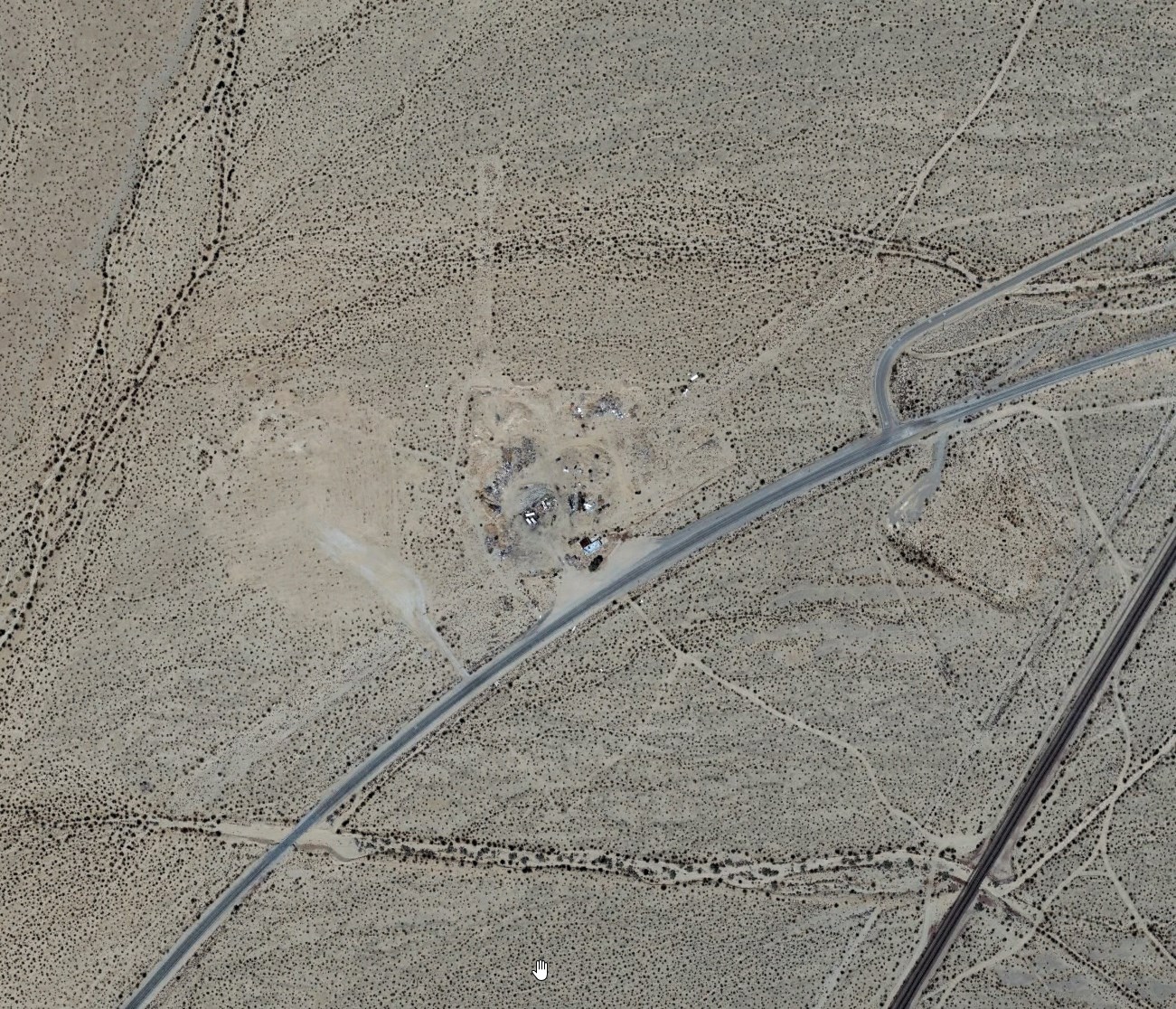
I visited the Essex GWEN site recently having heard that it was demolished but hoping for some interesting remains. For whatever reason, probably its (relative) proximity to Los Angeles, Essex is one of the better known GWEN sites. Wikipedia, for example, illustrates the articles on both GWEN and NDGPS with photos of the NDGPS installation at Essex. Treasure those photos, because what they depict is long gone. The demolition contractor did an admirable job on the cleanup, and you could easily pass by without knowing there was anything near the size of a 300' radio mast in this clear spot in the desert.

Several depressions in the ground might reflect the locations of guy anchors for the tower, in some of them what I believe to be remnants of the buried ground screen are visible.
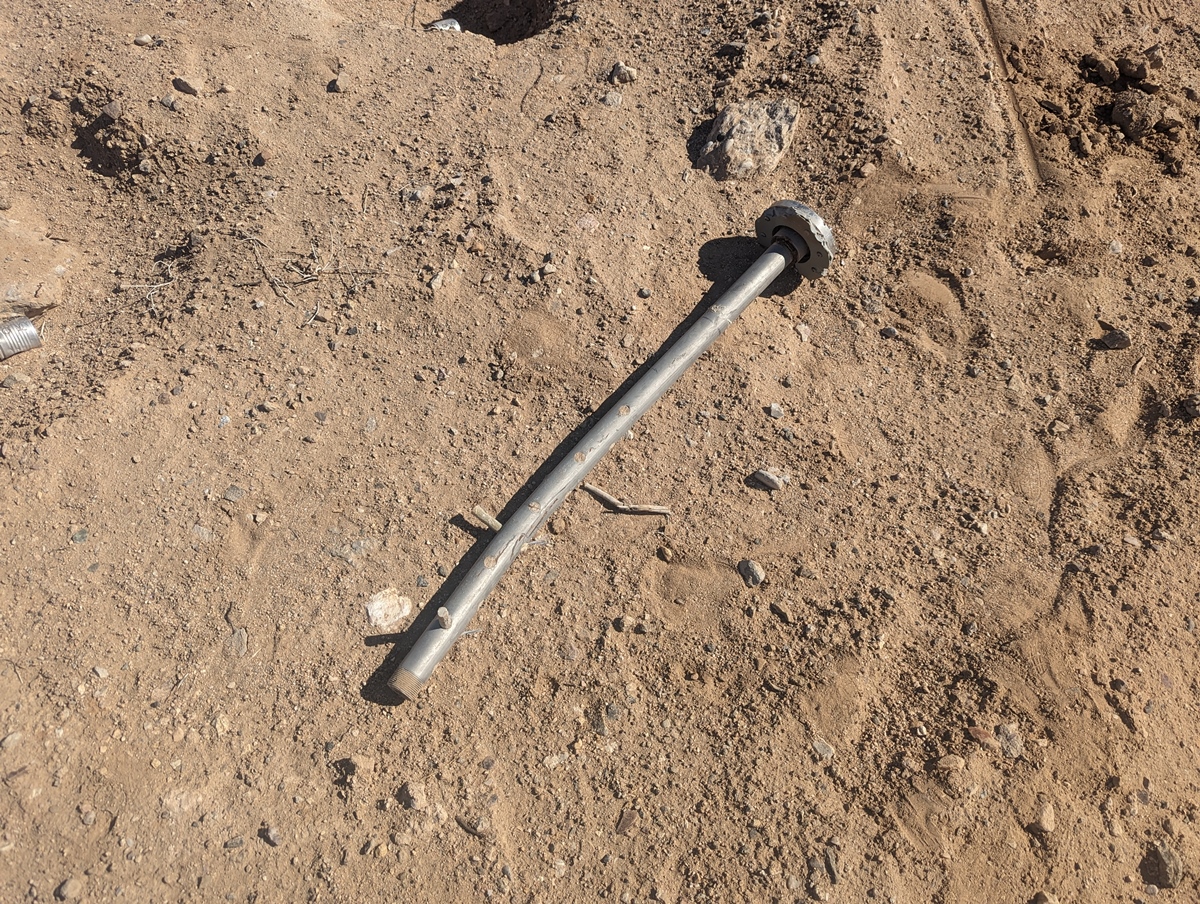
The most substantial artifact on the site is hard to identify but looks to my eyes like it could have been part of the hardware of an antenna. It is made of aluminum, has regular holes drilled in it, and gives the impression that it used to project from a plastic housing.
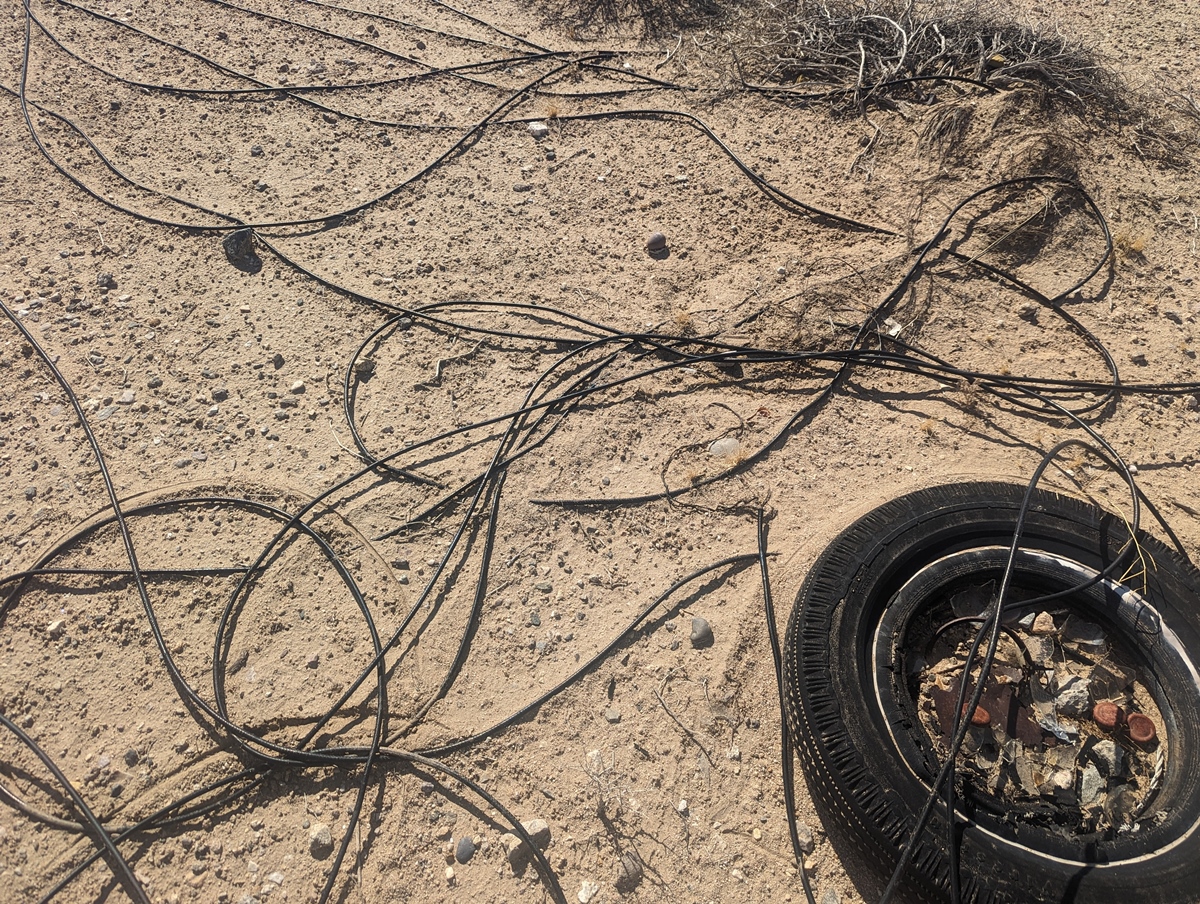
The surest indication this is a former radio site comes from a pile of coaxial cable, occasionally tangled in the desert scrub. This is rather light cable and was probably connected to one of the receive antennas. There is fifty to a hundred feet of it scattered about. It may have been pulled out of a buried conduit connecting shelters.
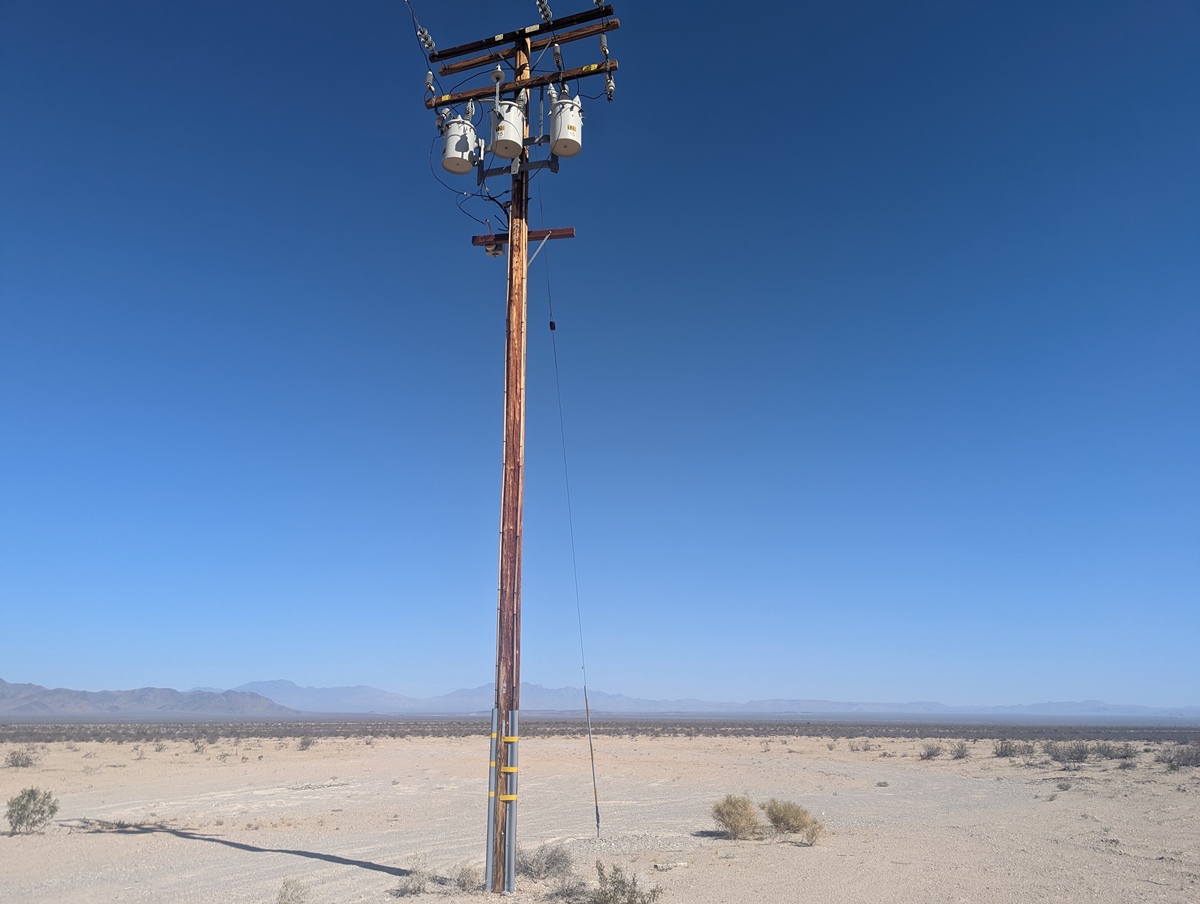
The site was removed only recently, and the electric utility apparently kept the service in good shape up to that point. At the edge of the site, a utility pole provided three-phase service that once went into an underground conduit.
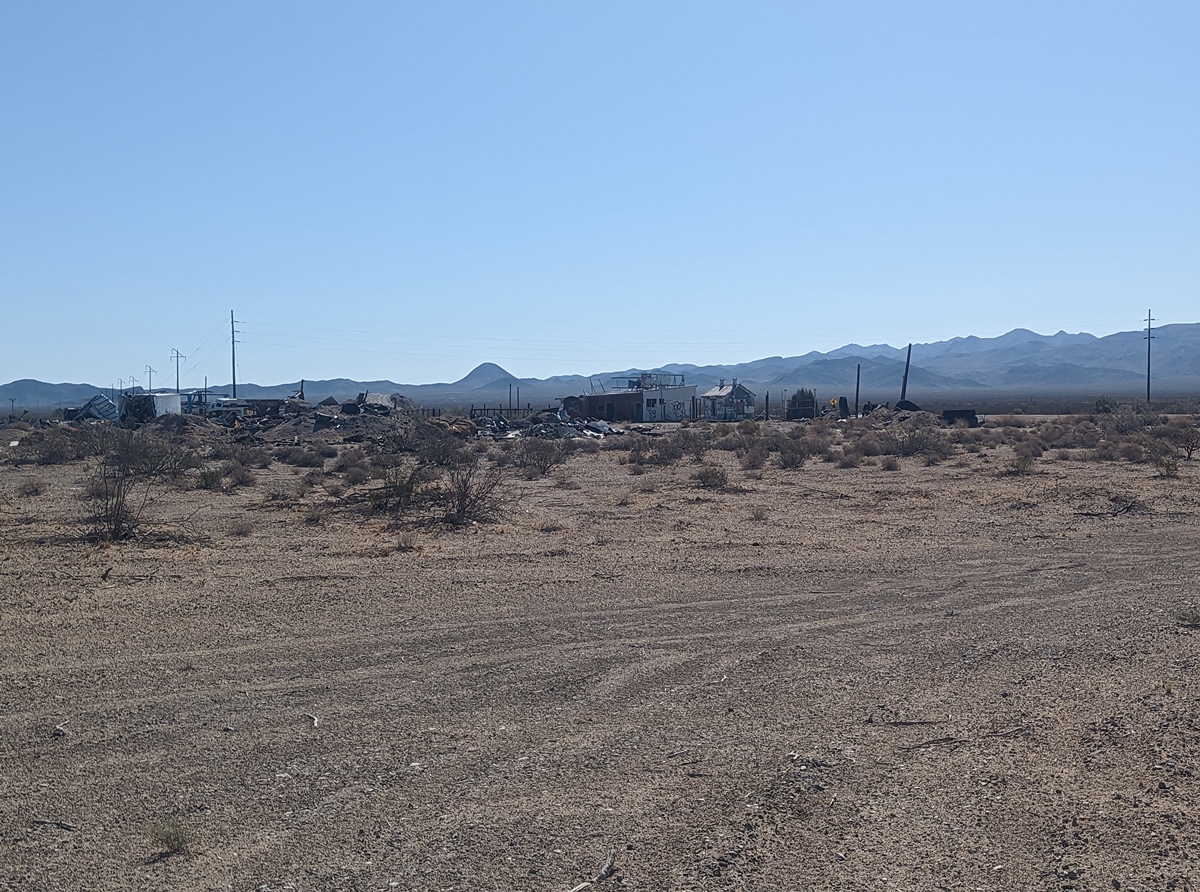
Despite my comments on its isolation, this GWEN site does have a neighbor: it appears to be an old service station, but its history is clearly linked to the airfield found just a short distance to the north.
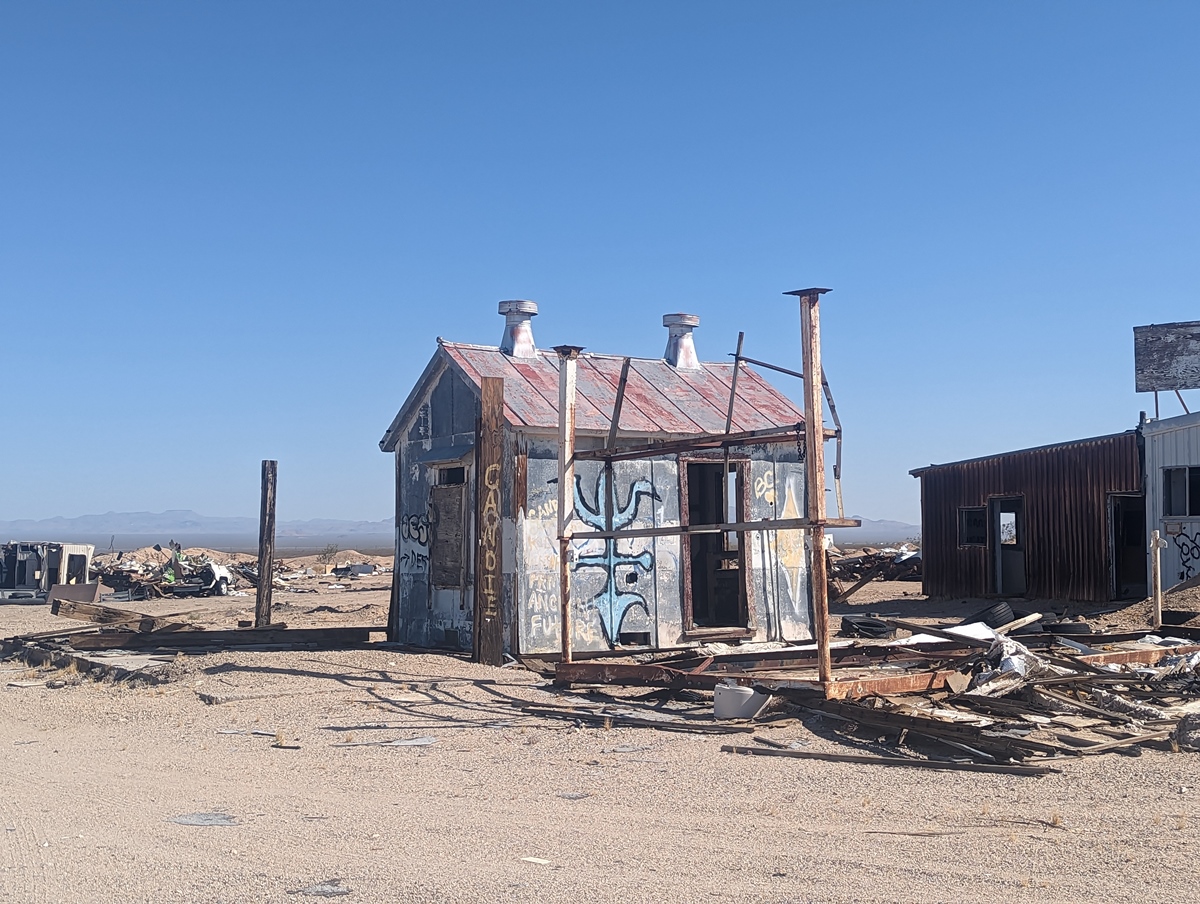
It seems to have been moved, but a sheet-metal shed adjacent to the old service station is recognizably the generator shed from a Civil Air Administration route beacon. The orange-painted roof, for visibility to aircraft, is just holding onto some paint. Originally this would have had a tower adjacent, and possibly even would have sat on an arrow-shaped orange concrete foundation.
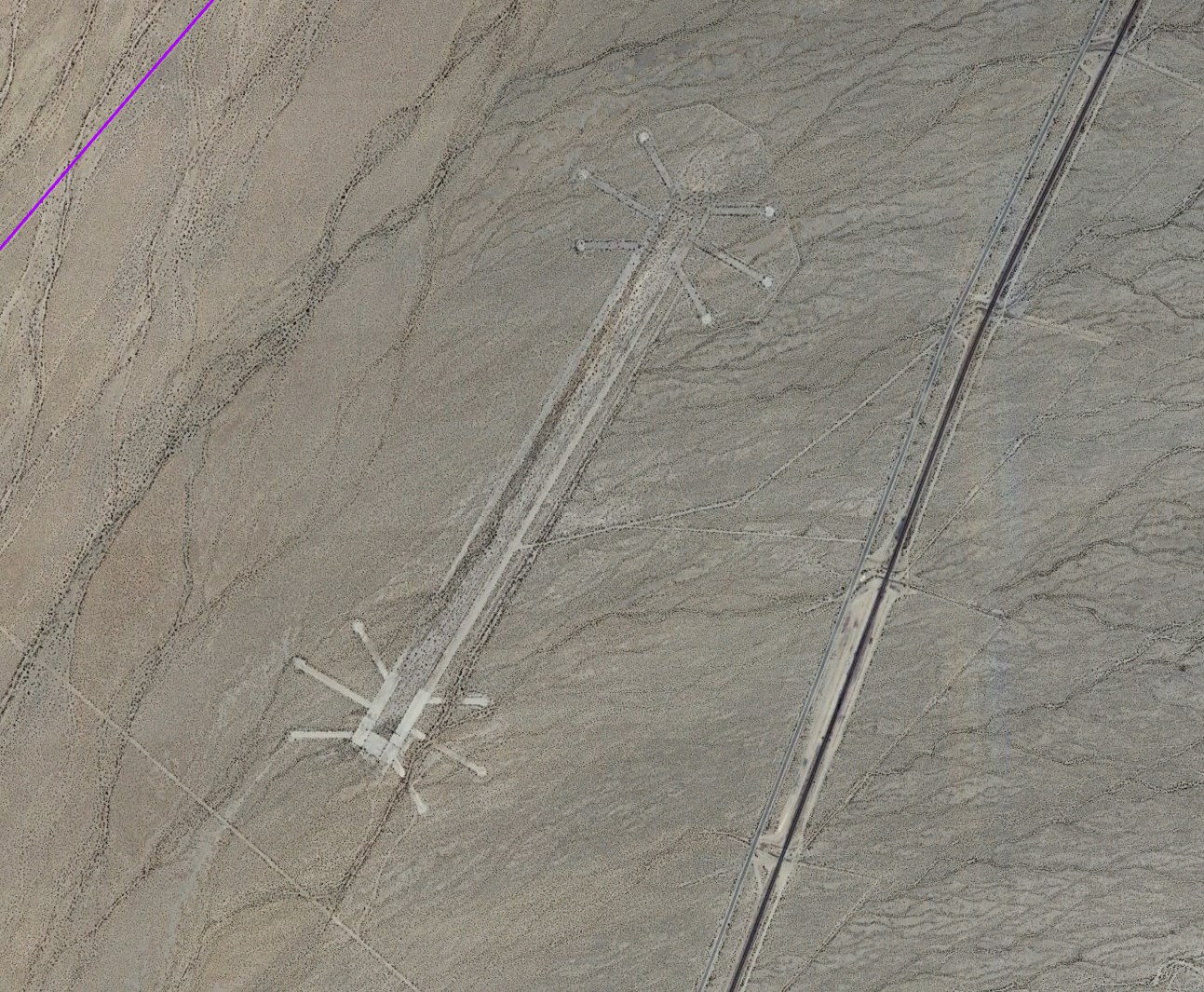
The Mojave Desert was extensively used for military training during World War II, and the remains of temporary military installations abound. The CAA-type beacon hut leads me to assume that there was an airfield at this location built by the Civil Air Administration, but it was clearly redeveloped by the Army as the Essex Army Airfield. This airfield supported the Essex Divisional Camp of the Desert Training Center, through which millions of men passed on their way to the second World War. It's only one mile north of the Essex GWEN site, the kind of coincidence that is common in the Mojave desert: it is barren of life but surprisingly dense with history.

The airfield is surprisingly large, reportedly built to accommodate A-20s. The actual runway, a steel mat down the center, is long gone. The dirt-concrete blend taxiways on the side have fared better, and I think a light aircraft with backcountry gear and an adventurous pilot could still set down on the eastern taxiway. I don't recommend the attempt.
Overall the site is very overgrown. The access road is clear in satellite imagery but, as is often the case, far less clear from the ground. We had trouble finding it but after a few passes navigated around scrub, through washouts, and over a berm onto a taxiway. Only as we left did we realize where the actual access road met the airfield; we had just driven up a coincidentally road-like wash.
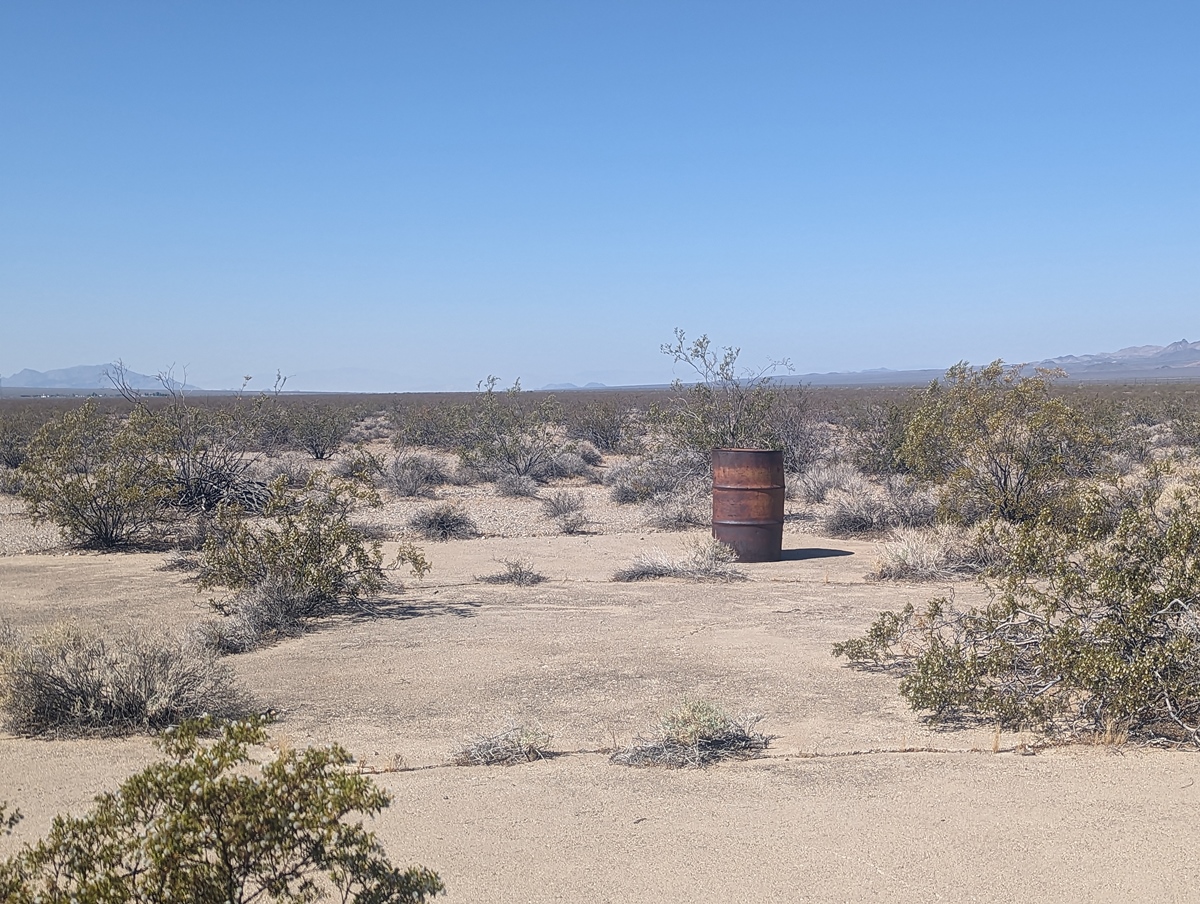
12 tie-downs surround the airfield, arranged in a curious asterisk pattern at each end. They're probably the best enduring parts of the airfield. I looked over these peripheral areas carefully, hoping to find artifacts of the apparently fairly busy military operation here, and ideally the original foundation of the CAA beacon. Instead I found a 55-gallon drum, a plastic jerry can of recent origin, and a large desert tortoise enjoying the sun. The latter is a rare find, but not the one I expected.
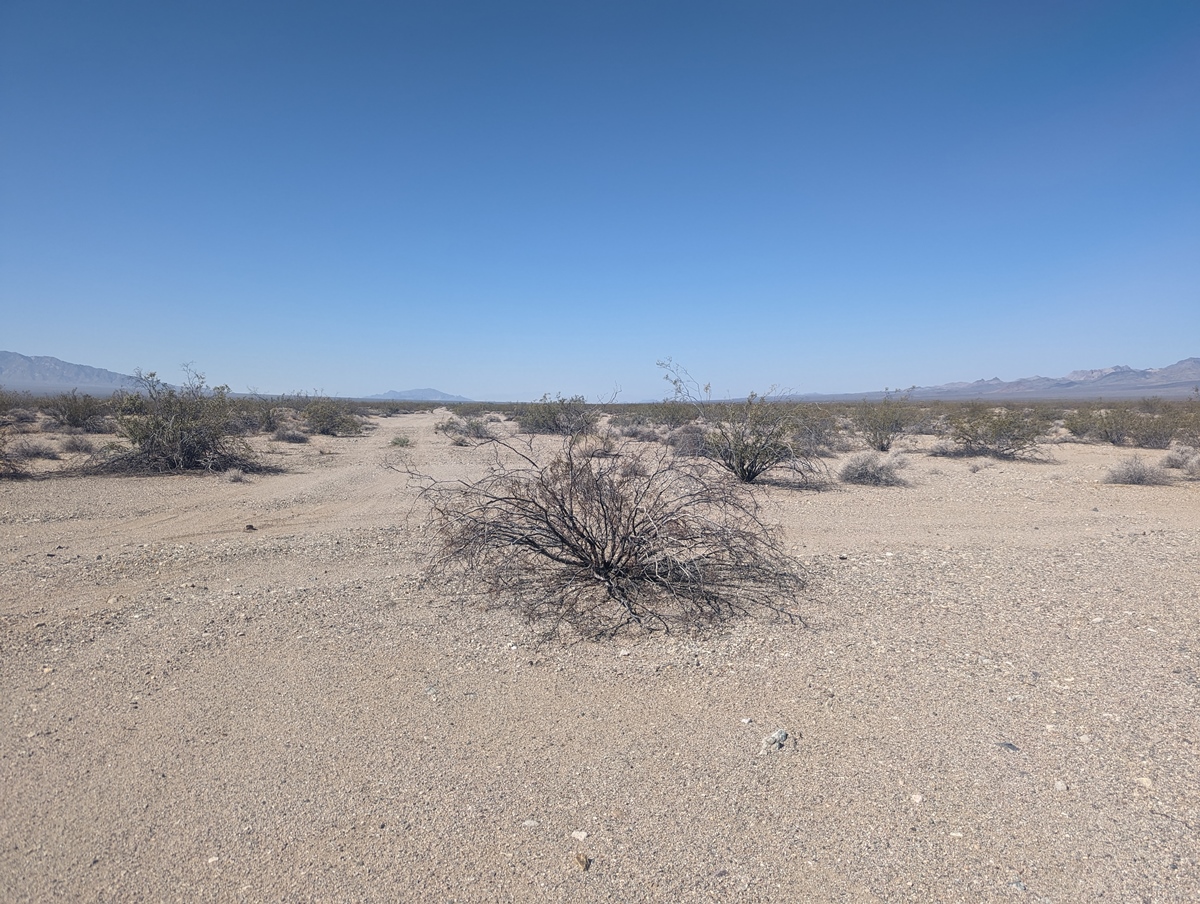
The runway, never paved, is filling in with bushes. The middle has started to wash out. The airfield will be visible from above for a century, but in a matter of a decade it might be hard to make out on the ground.
The Defense Baseline Route, a long-distance telephone line quickly strung along the length of the West Coast as a wartime exigency, passes only a few miles West. This is one of the segments still standing, although most of the DBR has been removed. Just to the south, the Santa Fe Railroad's transcontinental line makes for Los Angeles. Essex exists because of the railroad; its water tank apparently supplied not only passing steam locomotives but the army camp.
There's a lot out here, but you have to look carefully for it.
[1] This organization went through a succession of reorganizations and names over years, including the Philips Laboratory. Today, it's mostly the Directed Energy directorate of the larger Air Force Research Laboratory.